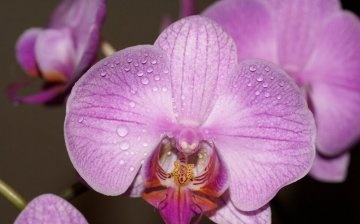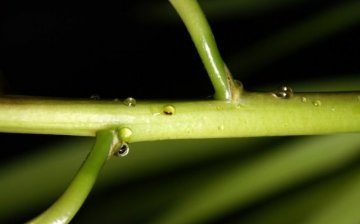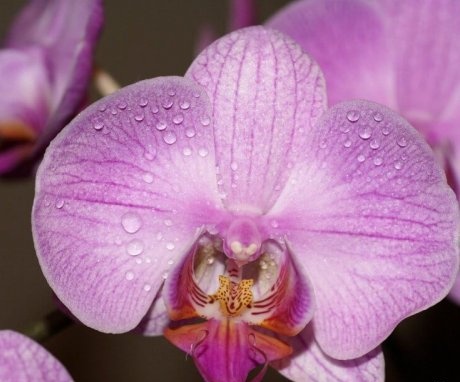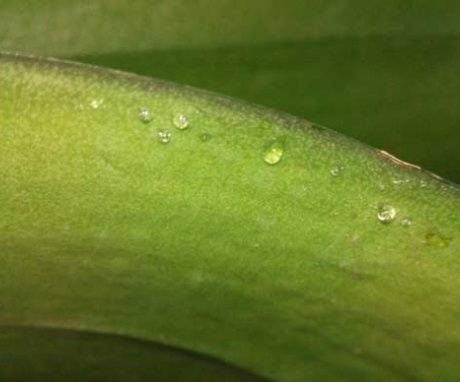Sticky drops on an orchid: what it means and why they appear
After seeing sticky drops on an orchid, most beginners wonder what it is. Someone does not pay attention, others, on the contrary, begin to sound the alarm.
Sticky drops can be found:
- on flowers;
- on peduncles;
- on sheet plates;
- on new growths of sympodial orchids.
In addition to the appearance of nectar, this is a signal to pay attention to the health and conditions of the plant.
Nectar
To attract pollinators for further reproduction, almost all flowering plants secrete nectar. Not all orchids form it using other methods of attracting insects. The nectar can be located on a column, lip or spur. This is a natural process, it is not a disease.
Sticky drops on peduncles
First of all, droplets are striking, which are formed on the flower arrows of Phalaenopsis, Cattleyas, Cambria, Dendrobiums and other types of orchids.
Why do sweet drops appear
In order to understand where they come from, one should consider how photosynthesis in plants takes place, that is, the process of forming new cells from carbon dioxide and water in the light with the help of chlorophyll.
Inside the orchid, carbon dioxide reacts with water to form oxygen and glucose. With the sap of plants, it enters the places of formation of new cells. There, the glucose breaks down, releasing energy, which promotes the growth of the orchid. This process is called aerobic respiration. Glucose, which did not have time to decompose into carbon dioxide and water, appears on the peduncles, since in a flowering plant all the energy is directed there.
Sticky drops on new growths of Dendrobiums, Cumbria and Cattleyas
Sometimes beginners believe that sweet drops appear on the trunk of the plant. This is not true. Monopodial orchids such as Phalaenopsis or Vanda leaves cover the central core so tightly that it becomes visible only when the leaf plates age and fall off. In this place, no cell growth occurs, so the plant does not send glucose there.
As for sympodial orchids, pseudobulbs are mistaken for stems, on which, during their growth, sweet drops, which are not processed glucose, can also appear.
Adhesive substance on sheet plates
When sweet drops appear on young leaves of Phalaenopsis, this can still be explained by excessive photosynthesis. But if they formed on old leaves, then this should alert the owner of the orchid.
Pests
There are several types of insects that secrete a sticky secret liquid - pad. These include:
- Mealybugs.
- Aphid.
- Shield.
If you do not pay attention to them in time, then their appearance on orchids can cause the death of the plant.
Mealybugs
The gummy substance is released by females in the course of their life. They are insects of white, pink or beige color with transverse grooves on the body, 3.5-5 mm in size. Females form around themselves, similar to cotton, cocoon of wax. Males are a flying insect with transparent wings, do not emit honeydew.
In addition to sticky spots, mealybugs leave a white cotton bloom on orchids. It can be both on the inside and on the outside of the sheet plates.With severe damage, they acquire a marbled color. The pests themselves accumulate in the leaf axils.
Aphid
These are small, 1-4 mm, green, yellow or black insects, so it is not difficult to see them. You just have to look carefully. Aphids like to settle on flowers, young growth and orchid leaves. In addition, sweet drops attract ants to itself, which also does not add to the health of the plant.
Sucking the juice from young leaves, aphids inject poison, due to which the tissues weaken, deform and die off. The pad is a favorable environment for the development of fungal diseases.
Shield
Females are shield aphids, 0.5-5 mm, producing a specific wax, which forms a protective shield on top of it. Under it, the female lays eggs. The scutellum itself is convex, round or elongated, from light to dark brown.
Orchids with hard leaves are most loved: Phalaenopsis, Cymbidium and Cattleya. The sticky substance secreted by scale insects is an ideal habitat for sooty fungi. They have the appearance of a dark moldy bloom, do not allow sunlight to reach the leaves, interfering with the process of photosynthesis.
Diseases
The stickiness of the leaf blades can cause diseases such as powdery mildew. Fluff appears on the surface of the leaves, similar to flour - this is a mycelium with spores. With age, it becomes gray and wet. Slows down plant development by interfering with photosynthesis.
Ways to eliminate drips
Sticky spots can simply be washed off with water, but this will not stop them from reappearing. To get rid of them, it is necessary to take measures to optimize the conditions for keeping the orchid, since the root of all troubles lies precisely in this. The release of glucose and the appearance of pests are the result of improper agricultural practices.
Orchid keeping conditions
As diverse as the world of orchids is, so are the conditions that favor their growth and development. But for this it is necessary to maintain a balance: the energy of the sun + temperature + water = oxygen + glucose.
Lighting
Light for orchids is the main source of energy for photosynthesis. The required intensity, depending on the type, ranges from 15,000 to 30,000 lux. The length of daylight also plays an important role. Each orchid has its own light border. If the lighting is higher, it develops, if it is lower, then it sleeps.
Temperature regime
According to the requirements for air temperature, orchids are conventionally divided into 3 types:
- Warm - they prefer from + 20 ° С to + 35 ° С. These include Wandas, some Cattleya species.
- Moderate - from + 16 ° С to + 28 ° С. Of the widespread, these are Phalaenopsis, Dendrobiums, Cumbria, Cattleya.
- Cold - from + 10 ° С to + 20 ° С. These include Cymbidiums and rocky Lelias.
If it is disturbed, then photosynthesis slows down, or stops altogether. This leads to a loss of immunity.
Watering
Water is the third ingredient in orchid health. But if the flow of moisture to the plant does not meet its needs at the moment, this will lead to the death of the orchid. It is very important that the ratio of light, temperature and water are in balance.
In bright sun and high temperatures, an orchid that is in the stage of active growth is able to process all the water that it got during watering. But if there is not enough light for her, it is cold, and she “sleeps”, then excess moisture will lead to such a disease as powdery mildew.
In addition to these main 3 factors, the appearance of sticky drops is influenced by:
- air humidity;
- poor ventilation of the room;
- overfeeding with nitrogen fertilizers;
- hard water.
The air humidity should correspond, or be slightly lower than that which promotes the growth of the orchid: the higher the temperature, the more it should be.
Top dressing
Many beginners mistakenly believe that in order for an orchid to grow faster, it needs to be intensive feed... Such "efforts" often lead to the opposite result.This is especially true for nitrogen fertilizers.
When the plant is oversaturated with this substance:
- fabrics soften and crack;
- the flowering period becomes shorter;
- immunity is lost, the orchid is sick more often;
- is more likely to be attacked by pests.
To prevent this from happening, orchids should be fed with balanced fertilizers marked “For orchids”. This is done in the spring and summer.
How a violation of agricultural technology leads to the appearance of sticky drops
How does a violation of the conditions of detention affect the appearance of a sweet substance on orchids, in particular on Phalaenopsis:
- Short daylight hours, low air humidity, coolness, high nitrogen content, leads to damage by mealybugs.
- Air humidity less than 30%, lack of iron or excess nitrogen provokes the appearance of aphids.
- Little light, improper watering, too hot or cold, a lot of nitrogen, and the orchid is affected by the scale insect.
- Very high humidity at low temperatures, and poor light conditions cause powdery mildew disease.
- Lack of light and excessive watering lead to the release of glucose, that is, the appearance of sticky drops. They are a tasty dish for many pests. In particular, for the tick, which infecting plants, opens up access to infectious, viral and fungal diseases.
To avoid all this, one must be guided by the principle that it is better to prevent than to cure later.
Prevention of pests and diseases
Most often, Phalaenopsis from flower shops and hypermarkets appear on the windowsills of florists. Having brought an orchid home, the happy owner of a tropical miracle puts it in the most prominent place or puts it in his collection. In order not to later regret the deceased Phalaenopsis, you must immediately take care of his health:
- treat pests;
- choose a sufficiently lit place;
- make sure that the temperature of the content matches the type;
- water with settled water in the morning, when the substrate is completely dry;
- try to ensure air humidity of at least 40-45%.
If trouble could not be avoided, then you will have to resort to more effective measures.
Powdery mildew treatment
First of all, it is necessary to reduce the humidity of the air and increase the temperature. You can clean the leaves from fungal plaque with vodka, diluted calendula tincture or Neem oil. Treat Phalaenopsis with an antifungal fungicide. In the future, carefully monitor the state of the orchid.
Getting rid of pests
Insects that leave sticky drops on the leaf plates of Phalaenopsis are easily distinguishable with the naked eye. In order to prevent the growth of the population, it is necessary to carefully examine the orchid at each watering. Pay particular attention to the axils of the leaves, their seamy side and growth points.
If cotton sprays or white hemispheres are visible, then this is a mealybug or scale insect. First, they must be removed mechanically: under running water or with a swab dipped in an alcohol solution. Wipe all leaf axils with a cotton swab.
Since the bodies of insects are covered with a shield, then of the chemical preparations it is necessary to use systemic ones, they penetrate into the juice of the orchid and make it poisonous to insects. Oil-based pesticides should only be applied to the affected areas, otherwise they will block the stomata on the leaf plates.
Treatments are carried out until the entire colony dies, with a frequency of 7-10 days. If insects appear, then they must be immediately removed with a cotton swab or a swab dipped in vodka. At this time, fertilizers cannot be used in general, and with nitrogen content in particular, growth stimulants and growth regulators.
To combat aphids, you can use any insecticide that acts on it. The treatment should be carried out at least 3 times, but the preparations should be with different active ingredients, since aphids quickly become resistant to one poison.
It is not difficult to understand and understand that when sticky drops appear on Phalaenopsis and other orchids, one should not panic. You should consider the plant from all sides, analyze, and create such conditions to avoid similar problems in the future. Then the tropical beauty will delight the owner with her flowering for more than one year.
Related videos:












On our phalaenopsis orchid, droplets have never appeared, either on flowers or on leaves. On the contrary, an orchid flower resembles paper. Orchids bloom for a very long time, a month, or even longer, and there may be more than a dozen flowers on one peduncle.